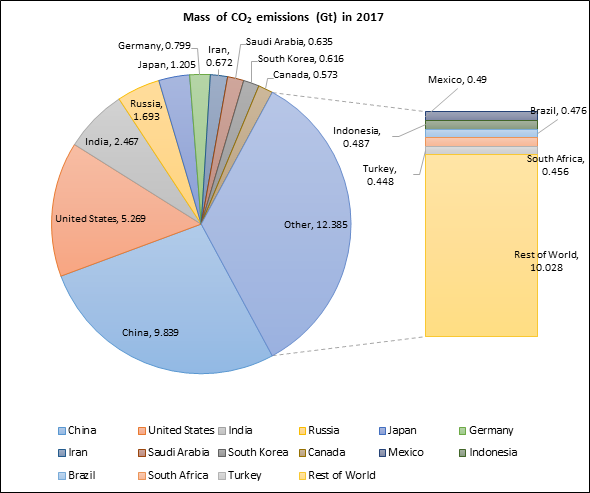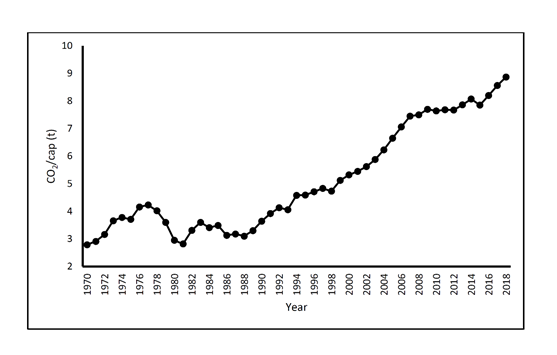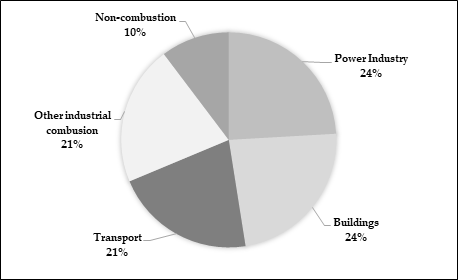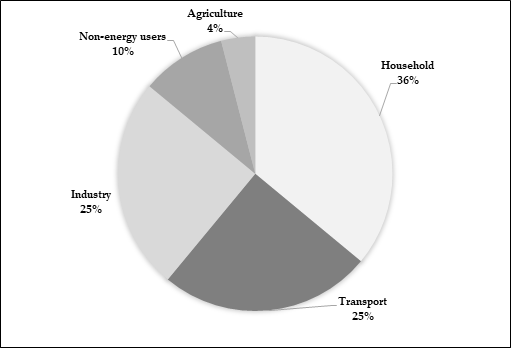- Household
- Energy consumption
- CO2 emissions
- Iran
- Introduction
Energy consumption and related carbon dioxide (CO2) emissions are complex issues at different countries because various factors influence energy supply, energy demand, and energy consumption on a global or local scale [1]. It has been demonstrated that high demand for energy consumption is associated with an increased need for the use of fossil fuels [2]. In developing countries, the most important challenges in the sector of energy are environmental degradation with regard to the use of fossil fuels, CO2 emissions, and hard access to modern energies such as liquefied petroleum gas (LPG) and renewable, eco-friendly energy sources [3]. In this regard, the public tendency towards using these resources in different counties has been increased [4,5]. Besides, the rate of urbanization and consequently the number of households have been increased in developing countries, which caused more challenges in supplying necessary energy in different sectors [6,7].
It is now well established from a variety of studies that households impact greenhouse gas (GHG) emissions. Druckman and Jackson [8] declared that the amount of GHG emission depends on the amount of energy consumed in households. Therefore, the households’ behavior should be changed to lessen the issues related to energy consumption and climate footprint. In this regard, waste management is one of the key priorities of environmental policy in reducing GHG emissions [9]. In terms of the consumed energy, the GHGs intensity differs from different sources. For instance, the amount of emitted GHGs from burning natural gas is estimated to achieve less toxic air pollution rather than the pollution from the coal source in power plants [10]. According to Oladokun and Odesola [11], there are two important strategies, which need to be made for reducing GHGs emission, namely energy conservation and change in households’ behavior.
Findings from different lifestyles indicate that households’ behavior impact on energy consumption. For instance, households in the UK and Sweden have, respectively, consumed 21% and 51% of the energy in using dishwashers in 1998 [12]. A comparison of the two results from China and the EU reveals that Chinese households traditionally use cold-water for washing the clothes, whereas hot-water is used in the EU’ households. According to an investigation by Streimikiene and Volochovic [9], substantial differences have been found among nations to be related to lighting, household size, room temperature, and operating hours of commercial building.
From the 1970s, the lifestyle of Iranian households has been pursued to a higher living standard. A report by the Statistical Center of Iran [13] shows that Iranian’s per capita disposal income has been increased from USD 10 to USD 25 from 1990 to 2016, respectively. As far as the disposal income increased, the direct energy consumption in Iran also moved upward 51% [13] from 1.658 8 GJ to 2.505 8 GJ. In contrast to other sectors like industries, the report by Statistical Center of Iran (SCI) shows a decreased rate of direct energy consumption from 16.4% to 10.7% by Iranian households. It seems possible that this discrepancy is due to the low share of household direct energy consumption in GDP [14].
Exceptionally, for the last six decades, Iran has been viewed as a nation with a rapid rate of urbanization, increasing from 31% in 1956 to 75% in 2018 [15]. Although Iran is considered one of the main members in the Organization of the Petroleum Exporting Countries (OPEC), the international sanctions prohibit the export of produced oil and natural gas. Due to easy access to the energy sources in Iran, a considerable amount of these resources are consumed by different sectors of Iranian society [16]. In this regard, the rate of energy consumption and CO2 emission in Iran has been increased by 6.2 and 6.1 times, respectively, in the last six decades [17]. Iran is placed among the top 10 countries concerning CO2 emission (Figure 1). It is encountering a fast urbanization rate owing to social-political transformation and industrialization [18,19]. Taking into account the urban settlement within 1960–2017, the urbanization rate increased 2.2 times in Iran [20]. Hence, it caused a significant increment in energy consumption mainly extracted from natural resources [21].
Figure 1. Main countries responsible for global CO2 emissions, modified from [22].
As a result, Iran’s energy policy is mostly focused on the sector of industries rather than the residential sector. The existing studies on energy consumption are extensive and focus particularly on the economic development and the industrial sector in Iran [4,18,23–26]. In a study investigating energy intensity in Iran, Farajzadeh and Nematollahi [27] reported that the residential sector is responsible for about 20% and 33% of total energy consumption and CO2 emission in Iran, respectively. Therefore, this overview seeks to obtain data that will help to address household energy consumption and related CO2 emission in Iran. The results from this overview make a major contribution to research in terms of reducing CO2 emission by households.
The complexity of issues arising from energy consumption, environment, and sustainable development, and related CO2 emissions has resulted in the need for a comprehensive study into energy consumption by households in Iran. A study on households’ energy consumption and CO2 emissions in cities is important to a country like Iran with a population of more than 80 million and an urbanization rate of 3.5% [13]. The share of households in the total energy demand in Iran in 2010 has been about 25% and increased to 50% in 2019 [19,28], which makes it the highest compared to other sectors. Against this backdrop, a study on household energy consumption patterns is necessary considering the important role energy plays in human development. The energy demand of other sectors (e.g., industrial, agriculture and transportation) in any economy is better captured than the household sector due to centralized ownership, self-interest and increased level of regulation and documentation compared to the residential sector, which is not well defined [29] However, the adoption of disaggregated data on various energy sources used by households in this study gives room for an inquiry into variations that may occur in the energy consumption pattern between the different socio-economic segments in cities.
In addition, the reasons for the preference of any particular energy source(s) are examined by the study. Another possible area of the study would be to investigate households’ energy conservation. For a developing country such as Iran, much attention has been paid on the supply side whenever the issue of household energy is mentioned. In the context of climate change and the attendant global warming resulting from the unsustainable consumption pattern of humans especially city dwellers, attention is now focused on lifestyles and attitude of people with regard to energy consumption and CO2 emissions. In this regard, this overview examines households’ energy consumption and CO2 emissions in Iran towards energy conservation pattern from households for meeting their energy needs. It is hoped that knowledge about the existing consumption across the household sector will help policymakers in formulating policies that will enhance sustainable energy supply and consumption in the country.
- Household Energy Consumption and CO2 Emission
A considerable portion of energy demand and consumption in the world is used in cities. An estimation analyzed by the International Energy Agency [65] shows that the world has experienced about two times the growth of energy consumption from 2010 to 2018. In this regard, about 80% of energy consumption has been attributed to cities. From Figure 2, energy consumption and related CO2 emission show a considerable increase in CO2 per capita from 7.64 metric tons in 2010 to 8.87 metric tons in 2018 [63]. The urbanization caused to significantly increase the CO2 emissions in cities by shifting energy sources [65]. More recently, there has been worldwide recognition of the problems associated with greenhouse gas (GHG) emissions within and outside of city boundaries [66–68]. Along with the growth of energy consumption and GHG emissions, however, there is not a direct relationship to recognize energy consumption as an indicator of GHG emissions [69]. According to Mondani et al. [70], energy indicators are categorized as energy use efficiency, energy productivity, specific energy and net energy. Energy consumed in cities can be produced from different sources, including electricity and fossil fuels, each with a different climate footprint [65]. Although the efficacy of produced energy influences the amount of GHG emissions, the energy consumption impacts on GHG emissions through the amount of energy consumed, GHG intensity, and GHG emissions factor [71]. It is therefore likely that a significant preeminence should be made between energy consumption and energy supply [72].
Figure 2. Per capita CO2 emissions in Iran, modified from [63].
There are five primary sources for CO2 emissions in Iran (Figure 3), in which industry and household sectors are responsible for 24.1% and 23.4% CO2 emission, respectively. The results are in accordant to the globally main source of industry sector, which produces more than one quarter (26%) of total carbon emissions [73]. As shown in Figure 3, the second primary source is households with 23.4% of CO2 emissions. The transportation sector is emitting 21.2% of total CO2 emissions, and other sectors is considered as the sources of 31.3% of total CO2 emissions in Iran. So, households are directly the producer of about one-fourth of Iran CO2 emissions. With a combination of transportation and household sectors, 44.6% of CO2 emissions have resulted from urban and rural communities. In another way, the residential sector represents an essential role in the effort for emissions reduction, and households are thus a talented group when addressing energy conservation [74]. A consensus exists among scholars and planners at a neighborhood level indicating that household CO2 emission is related to the density, accessibility to employment, land-use combination, and vicinity to the public transit [75]. Iran’s carbon emission will increase to 15.1 metric tons and 9.5 metric tons CO2 per year without and with countermeasures, respectively, by 2030 [15]. Iran’s CO2 emissions have been increased by 5% annually between 1990 and 2016, whereas the global average for the same period is 2.3% [65].
Figure 3. Fossil CO2 emissions by different sectors in Iran, modified from [76].
Information, motivation, and responsibility are the basis for the household’s quantity of CO2 emission [8]. Some factors affect several instruments including incentives for energy savings, information given by campaigns, energy consultancy, workshops, feedback projects, and publications [77]. Considering the essential role of general public opinion in triggering the consumer’s performance, the mentioned factors can significantly contribute to the individual energy savings and increasing the interest and knowledge regarding energy consumption [78]. Learning about the costs and performance of energy-efficient technologies is particularly challenging since their benefits are usually not directly observable. For instance, an energy bill is typically given for the households in Iran providing no individual end-uses breakdown as well as no information on GHG emissions. Proving sufficient feedback to consumers regarding their energy use and on the potential effect of their efficiency investments is essential [79].
Rebound Effects
Rebound effects partly explain why total household energy consumption rises when the energy efficiency of the production sector improves [80,81]. With the existence of a rebound effect, energy efficiency policies may serve the goals of promoting economic growth. However, energy efficiency improvement may lead to more resource use in absolute terms. Rebound effects are composed of four levels. The first level is the price effect. For producers, increased productivity reduces production costs and theoretically enables an increase in supply. The second level is the income effect. When costs per unit of output fall, consumers can afford more energy-intensive products and services. Wilhite [82] points out that the introduction of new technologies may at the same time create new energy-intensive practices. The third is a replacement effect. As the share of energy use in total expenditures reduces, the demand for other goods and services rises, including goods and services that have a significant share of energy embodied in their production. The increased demand for new products and services requires more energy. The last level is a transformation effect. Fuel efficiency and other technological improvements alter human activity through changes in the allocation of time [83].
Household energy consumption increases in both developed and developing countries, even with significant energy efficiency improvements and strict energy price regulation [78,84]. However, this theory only concerns technological change and neglects the impact of changing consumer demand towards higher living standards [57]. Sustainable consumption indicates a research framework as well as directions of desired changes in household consumption behavior [58]. Empirical studies examine household energy consumption patterns of specific countries or regions and explore critical factors that affect household energy consumption [19,85].
- Influential Perspectives on Household Energy Consumption
The following subsections discuss the current research that explores critical drivers of household energy consumption from three perspectives: (1) factors from the production-side view, (2) factors from the household-side view, and (3) methods used to examine these factors.
3.1. Production-Side View
To comprehend the changing trends of energy consumption, decomposition analysis is normally utilized owing to a set of crucial comparable economic forces. There are changes in energy consumption normally categorized into structural changes and efficiency improvements [35]. Efficiency improvements reduce energy use to produce a product within a particular sector, while structural change is an alternative in the share of economic activities among industries (e.g., shifting from energy-intensive activities to less energy-intensive activities). Mulder and de Groot. [86] found that the structural change causes nearly all the decline in energy intensity in Norway and about half of the decline in Japan from 1970 to 2005.
Most of the decline to structural changes are attributed to early discussions of post-1978 changes in Iran’s energy intensity. Fundamental decomposition analysis was utilized by Sabetghadam [87] to test the energy use of Iran within 1981–1987 and indicated that all of the energy intensity reduction was nearly related to the technical change, however, the structural change accounted for a slight increment in energy intensity. The research boundary was further extended by Sabetghadam [87] for 1987–1992 and similar results were obtained. The study indicated that most of the drop in industrial energy intensity in Iran is related to energy efficiency enhancements. Sabetghadam [87] supported that efficiency improvements are the main contributor to aggregate energy intensity reductions but found further that structural change contributed little to energy intensity change. Studying structural change at different levels of aggregation may also yield different results.
3.2. Household-Side Analysis
Energy consumption behaviors that contribute to increasing energy demand are different in developing versus developed countries. In Mexico, cooking, water heating, lighting, and electrical appliances are the fast-growing end uses [88–90]. In Iran, water heating and space heating dominate the set of fast-growing energy end uses among households [28,36,91]. A typical individual’s consumption choice in modern society no longer has much to do with basic biological needs such as food or shelter [92–94]. Individuals’ choices concerning the amount and quantity of recreation, amusement, housing, food, and other consumables are linked to past or familiar experiences, cultural norms, peer influences, and other social influences, such as those from the media [95]. In this regard, De Almeida et al. [96] stated that entertainment loads and information technologies are crucial contributors to electricity demand. Compared to other countries with similar climates, the households’ demand shares for energy via space heating and cooling are rather low in Iran.
On the other hand, energy efficiency improvements can be locked-in to economies through changes in technology and infrastructure—the capital investments identified in the preceding paragraph. Infrastructures such as housing stock and public transportation parts of the hardware have an effect on the pattern of energy consumption. Household energy consumption is strongly influenced by dwelling type and age, surrounding structures, and other housing characteristics, such as insulation and building regulation [78]. Using double-glazed windows and more energy-efficient home appliances contribute to household energy conservation [85]. For instance, through such technological innovations, the energy consumption of dwellings built in the Netherlands is lowering after 1996 [97]. Interestingly the technological innovations are not always costly. A study conducted by Ürge-Vorsatz et al. [98] indicated that 32–33% of global building energy consumption for space heating can be conserved at a relatively low cost in the existing housing stock.
In Iran, urbanization is associated with both higher income and higher household energy consumption [19]. Moreover, increasing urbanization levels will lead to increased adoption of electronic home appliances, lighting, and other amenities [99]. Urban residents’ lifestyle changes further causes a growth trend of energy consumption. In developed countries, households in high-density areas are less energy-intensive [100]. Norman et al. [101] conducted a lifecycle analysis on two residential settlements with different density levels in Toronto and found that residents in high-density areas consume less than half of operational energy and produced half the greenhouse gas emission compared to their counterparts who live in low-density areas [101]. According to Ewing and Rong [102], households in sprawling regions are more likely to live in large, detached single-family houses, which consume more operational energy than do single-family houses in compact areas.
Furthermore, cultural and traditional attitudes toward certain goods and behaviors can influence energy consumption preferences by households for a country such as Iran. Culture and traditions are typically passed from generation to generation and are primarily bestowed upon an individual over his or her lifetime. Abrahamse and Steg [30,103] suggest that socio-demographic factors such as income and household size shape households’ opportunities and basic needs for energy, while reductions in energy use require a conscious effort—a change in households’ behaviors [104]. Wilhite et al. [105] compared energy use behaviors in Japan and Norway and found very different space heating, lighting, and hot water use between the two countries. Not surprisingly, higher hot water usage in Japan was caused by the bathing habit in Japan (both publicly and privately), which had deep cultural roots [106]. Moreover, Norwegians tended to be more energy insensitive during lighting and heating, as they have less annual sunlight and a colder yearly average temperature [107]. Perhaps more surprisingly, however, is that Norwegians heated much of their living areas most of the time, while the Japanese tended to heat only rooms they were immediately using. Low energy prices in Norway may explain some of this discrepancy in behavior. But Sovacool and Griffiths [107] suggested that Norwegians also may have a cultural, physical, and psychological affinity for having all rooms heated.
3.3. Used Methods to Analyze Household Energy Consumption
Input–output (I–O) analysis is frequently used to calculate the total energy requirements of households [108–113]. Kok et al. [114] summarized three types of I–O analysis used by researchers. First is fundamental I–O energy analysis. This method is based on data for the production side of the economy and is useful for describing the environmental impacts of a specific country or comparing differences among countries. The second method combines I–O energy analysis with household survey data. In this method, the consumption data is from household expenditure surveys rather than I–O tables. It combines the energy intensities of different economic sectors or commodities with household expenditure survey data. This method can generate more information on the household level and compare the energy requirement of different household types. The third method combines life-cycle analysis with I–O analysis. It leads to more detailed information on both the production and consumption side. It is good at describing and explaining environmental impacts at the household level.
Based on the primary I–O method, Hajilary et al. [115] calculated CO2 emission from Iran’s household consumption and resulted that the household sector accounted for about 36% of total CO2 emissions generated through primary energy consumption (Figure 4). The results from Hajilary et al. [115] indicate that rising total population, urbanization, and household consumption per capita contributes to the growth of indirect CO2 emissions while reduced carbon intensity mitigates the increase in CO2 emissions.
Figure 4. Distribution of energy consumption in different sections in Iran [115]. Reproduced with copyright, Elsevier.
Bin and Dowlatabadi [92] proposed a consumer lifestyle approach (CLA) as an alternative paradigm to show the relationship between household consumption behaviors and their environmental impact. Their findings revealed that about 80% of the energy consumption and related CO2 emissions are in accordance with energy demand in the USA. In CLA, the consumer’s decision making is affected by five interacting groups: (1) external environmental factors (e.g., traditions and technology levels); (2) individual determinants (e.g., attitudes and personal preferences); (3) household characteristics (e.g., housing size, household types and size, and household income); (4) consumer choices (e.g., information and availability of goods and services); and (5) consequences (e.g., consumption related material, energy use, and environmental impacts).
Based on CLA, Soltani et al. [28] compute the direct and indirect energy consumption and related CO2 emissions of Iranian households in 2016. Household energy consumption was responsible for about 26% of total primary energy use and about 30% of total CO2 emission in Iran. They also compared household energy use and CO2 emission for different income levels. Soltani et al. [28] found that income has a considerable effect on the amount and structure of household indirect energy use in Iran. High-income households have a tendency to consume more energy indirectly through goods and services and have a more diversified indirect energy consumption structure.
Micro-level survey data are also widely used in determining household energy requirements [36,116,117]. Combining India’s national household expenditure survey data with the estimated energy intensities of production sectors, Pachauri [116] quantifies household direct and indirect energy requirements at the household level in 1993. Pachauri [116] also explores the critical influential factors of household energy requirements through multi-variable regression. Based on the same dataset for the year 1999, Narasimha Rao and Reddy [118] use a multinomial logit model to analyze critical factors that affect households’ energy choices for cooking and lighting in India. Moreover, Gould et al. [119] discussed the role of education and attitudes in cooking fuel choice in India and concluded that education is a strong predictor of LPG adoption. O’Neill and Chen [120] employed the residential energy consumption data to test the variables that affect the household energy use in the USA. O’Neill and Chen’s study reveals that some demographical factors, particularly household size, have a substantial influence on household energy use.
Recent micro-level studies of household energy consumption in Iran are at the city level [19,121]. Since Iran does not have national surveys that collect energy-related data for households, studies conducted by Soltani et al. [19] and Sadati and Edwards [121] on household energy consumption are at the micro-level. Thus, there appears to be room for micro-level studies that could contribute to a complete understanding of critical factors behind various household energy consumption patterns. Moshiri [36] indicated that micro survey data at the household estimate demands for energy consumption. An advantage of micro-level over the macro-level analysis is that the micro-level can control for the characteristics of households, and makes use of detailed information on capital and its utilization [36].
Knowing the essential elements that influence energy consumption has become very considerable [122]. In the supply-side view, a change in energy consumption is often decomposed into changes in energy efficiency, production input structure, consumption structure, and consumption level. Household-level analysis studies the effect of climate, socio-economic, social demographic, social-cultural, and behavioral factors. Environmental and socio-economic factors significantly affect households’ energy consumption. The impact of demographical change, cultural difference, and behavioral models are also examined in some empirical analyses and conceptual frameworks. The theoretical and modeling origin for the explanation of household energy consumption is “the energy ladder” theory. Moreover, “energy services” and “energy mix model” theories are considered.
This entry is adapted from the peer-reviewed paper 10.3390/pr8080994




